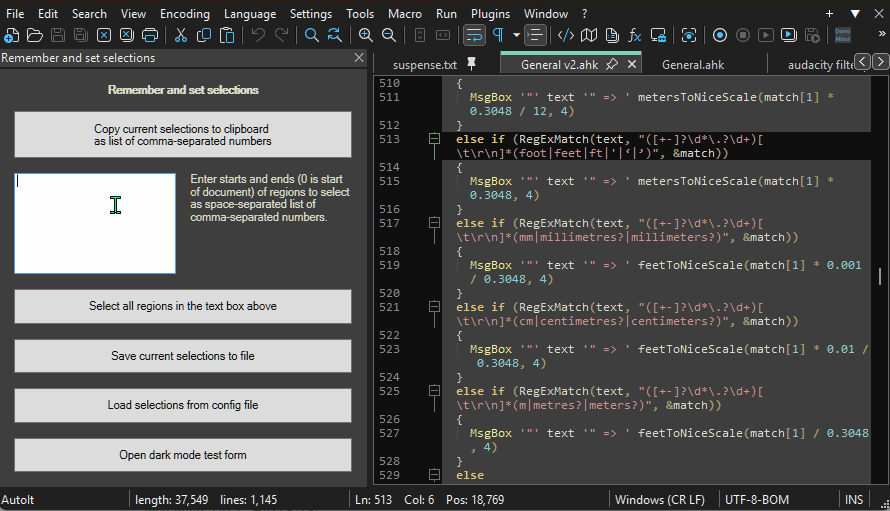Hi and I'm working on a WPF fork of NppCSharpPluginPack
-
@Jonathan-Johansen What is the benefit of using WPF instead of what we already have?
-
@Mark-Olson said in Hi and I'm working on a WPF fork of NppCSharpPluginPack:
@rdipardo is kind of a wizard when it comes to the low-level operation of forms
I’m also unfamiliar with WPF, but I can suggest to @Jonathan-Johansen that hosting the docking form on a
WindowsFormsHostmight be a better approach. That would at least provide access to a Win32-style window procedure, useful for debugging how (of if) theWM_CHARmessage is being handled.Alternatively, try to expose the window handle of the existing WPF
UserControland pass that to theNPPM_MODELESSDIALOGwrapper instead of theElementHost(as was tried already ). Or maybe there’s a way for WPF controls to broadcast messages to their child components…🤔? -
-
-
Update: when I inspect the WndProc messages that come through
$"{m.Msg} {m.WParam} {m.LParam}", I note these (mostly tangential, but I’d like to document them):- Pressing ‘normal’ keys (e.g. a-z, arrows, 0-9, punctuation) does not send a message to the ElementHostEx, but instead (after I turned the volume up on my laptop), it somehow triggers a bell sound.
- Mouse click comes through with
528 513 36634781and33 723656 33619969 - Switching to another program sends
8 0 0, and switching back to NPP sends1024 0 0 - Pasting into the TextBox works, but does not trigger any messages. Similarly for copying, deleting and backspacing.
- Opening the WPF About window sent
8 1116900 0
I’d like to convert the msg id to a string, I’m not familiar with their values. But there still aren’t that many messages, so perhaps I haven’t set up the dock panel correctly. I’ll try the same thing in the existing Forms version and see what comes up for comparison.
-
@Jonathan-Johansen Thanks for the clarification. I don’t develop Windows apps, so I just didn’t know what the two were. After looking at it, it seems that WinForms is more imperative and tightly coupled and WPF is more declarative and modular.
-
@pbarney no worries. I think your assessment is probably accurate, but of course you can do amazing things in both.
-
Another update: After trying lots of things, running Spy++, Copilot suggested putting a
Formaround theElementHost, and I’ve now got (when callingNppFormHelper.RegisterFormIfModeless) it doing something when I press a key, but I don’t think it’s that helpful - For every key press, I get many (>100) and only:13 = 0xD = WM_GETTEXTWParam is always256and LParam is always737269504944135 = 0x87 = WM_GETDLGCODEWParam and LParam are always0for these.
I found this page about windows message IDs, which was nice, but then I saw that Visual Studio has some special debugging
ToStringon System.Windows.Forms.Message` that tells you what the ID means when you mouse over during debugging. Nice. But anyway, still no key-specific events / messages.Well, because keyboard typing works when I don’t send
NPPM_MODELESSDIALOG, but cut/paste/delete works when I do, I’m thinking to look at what the message [2036] NPPM_MODELESSDIALOG does internally, to see if I can combine the good sides of both modes for a WPF version. -
@Jonathan-Johansen said in Hi and I'm working on a WPF fork of NppCSharpPluginPack:
look at what the message [2036] NPPM_MODELESSDIALOG does internally
Puts the window handle of the dialog on a list of window handles which are passed, in turn, to IsDialogMessage in the message loop. If that function returns true, no further message processing is done. If all calls return false, the message is passed to TranslateAccelerator, and if that returns false the message is translated and dispatched normally.
-
@Coises thanks! Sounds like I won’t find the answer there. And I looked up
WM_GETDLGCODEout of curiosity and figured it may help, then eventually found this SO question from 16 years ago, and will investigate fixing this way. It seems to be a pretty close fit for the issue here! -
And it works now! The latest push has enabled it. I cleared out the MSG logging display because it happily lets me type now. Thanks for all your help and input guys! I’ll let you guys know how it all comes together :)
-
I figure I’d better document the solution(s) for others that may tread this path. A summary of some of the steps needed (of course built on top of Mark’s work!):
- Ensure you register your modeless dialog with NPP (NPPM_MODELESSDIALOG, in Main.cs we call
NppFormHelper.RegisterFormIfModeless(Form, bool)) - The WPF
System.Windows.Controls.UserControlshould be in anSystem.Windows.Forms.Integration.ElementHost, which is in aSystem.Windows.Forms.Form. - I’ve subclassed the
ElementHostto handleWM_SHOWWINDOWto update theVisibleproperty, and to trigger a (slightly delayed) refresh of the visuals when we get aWM_SIZE. There I invalidate the visuals and update layouts. There may be a way to skip this, but it’s working, so I’m not trying to fix it. - In the WPF
UserControl, when it’sLoaded, we have to get the presentation source (as aHwndSource) and add a hook to respond to theWM_GETDLGCODEand tell the source that weDLGC_WANTCHARSandDLGC_WANTARROWS, and maybe we also needDLGC_HASSETSEL.
I’ve pulled most of it into a method called
MakeModelessDialog. And now for a short recording of it working!
- Ensure you register your modeless dialog with NPP (NPPM_MODELESSDIALOG, in Main.cs we call